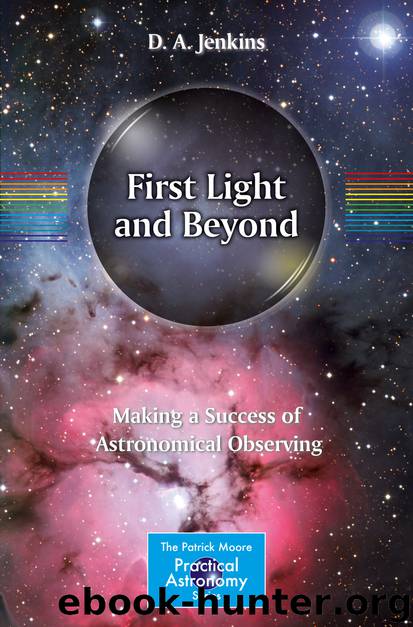First Light and Beyond by D. A. Jenkins

Author:D. A. Jenkins
Language: eng
Format: epub
Publisher: Springer International Publishing, Cham
Fig. 5.2The Sombrero Galaxy—M104—lies about 50 million light years away in the Virgo constellation. (Image courtesy of ESO/P. Barthel. Acknowledgments: Mark Neeser [Kapteyn Institute, Groningen] and Richard Hook [ST/ECF, Garching, Germany])
In 1919 Harlow Shapley of the Mount Wilson Observatory published a study that indicated a much larger size for our Milky Way Galaxy than previously thought. The result of his measurements of Cepheid stars in dozens of globular clusters led him to conclude that our galaxy is about 326,000 light years in diameter. Today we know that it has a diameter closer to 100,000 light years (except for a few straggling stars much farther out). However it was perhaps this revelation of a far larger Milky Way Galaxy that caused him to believe spiral nebulae were inside of our own galaxy and not independent star systems.
In 1920 Heber Curtis of the Lick Observatory took the opposite view of Shapley, and the two engaged in what has been referred to in modern astronomical history as the Great Debate, held at the National Academy of Sciences in Washington, D.C. Curtis promoted the idea that the spiral nebulae were not a part of our Milky Way, and that any lack of these spiral nebulae in the area of the Milky Way was due to obscuring dust hiding them from our view. He had observed these dust lanes in other spiral nebulae (galaxies) and so concluded that our own galaxy must have the same or a similar component.
Astronomers did not have to wait very long before the debate was settled. Clarity arrived when Edwin Hubble began his own examination of Cepheid variables in early 1924. With this new data he calculated that the Andromeda nebula (now known as the Andromeda Galaxy, M31) must be at least 1 million light years distant and therefore outside of our own Milky Way Galaxy. That year, like many other pivotal ones that came before it, would forever change astronomy and how we view our place in the universe. Edwin Hubble went on to classify galaxies into a few main types—elliptical, spiral, barred spiral, and irregular. Within those general classifications are many different variations. During the last century astronomers have observed a vast number of galaxies, and most of them do not seem to fit what may come to the average person’s mind if asked to describe a galaxy.
In 1959 Russian astronomer B.A. Vorontsov-Velyaminov (1904–1994) cataloged 355 galaxies that actually interact. Later that catalog grew to 852 such galaxies, and then to 2,014 (posthumously). Vorontsov-Velyaminov is also well known for the immense work Morphological Catalogue of Galaxies (MCG), containing 34,000 galaxies of magnitude 15.0 or brighter—well within reach of very large amateur telescopes. In 1966 famous astronomer Halton C. Arp (1927–2013) published his Atlas of Peculiar Galaxies. This list of galaxies calls attention to some of the most unique and peculiar-looking shapes of galaxies that can be observed in amateur telescopes. The Deep Sky Field Guide to Uranometria 2000.0 often refers to galaxies from these catalogs along with several others.
Download
This site does not store any files on its server. We only index and link to content provided by other sites. Please contact the content providers to delete copyright contents if any and email us, we'll remove relevant links or contents immediately.
In Control (The City Series) by Crystal Serowka(35789)
The Wolf Sea (The Oathsworn Series, Book 2) by Low Robert(34700)
We Ride Upon Sticks by Quan Barry(34002)
Crowbone (The Oathsworn Series, Book 5) by Low Robert(33054)
The Book of Dreams (Saxon Series) by Severin Tim(32914)
The Daughters of Foxcote Manor by Eve Chase(23054)
Trainspotting by Irvine Welsh(21025)
Call Me by Your Name by André Aciman(19903)
Shot Through The Heart (Supernature Book 1) by Edwin James(18428)
The Secret History by Donna Tartt(18163)
The Girl from the Opera House by Nancy Carson(15382)
American King (New Camelot #3) by Sierra Simone(14871)
All the Missing Girls by Megan Miranda(14737)
Sad Girls by Lang Leav(13910)
Pimp by Iceberg Slim(13779)
The Betrayed by Graham Heather(12301)
The Betrayed by David Hosp(12204)
4 3 2 1: A Novel by Paul Auster(11792)
Still Me by Jojo Moyes(10788)
